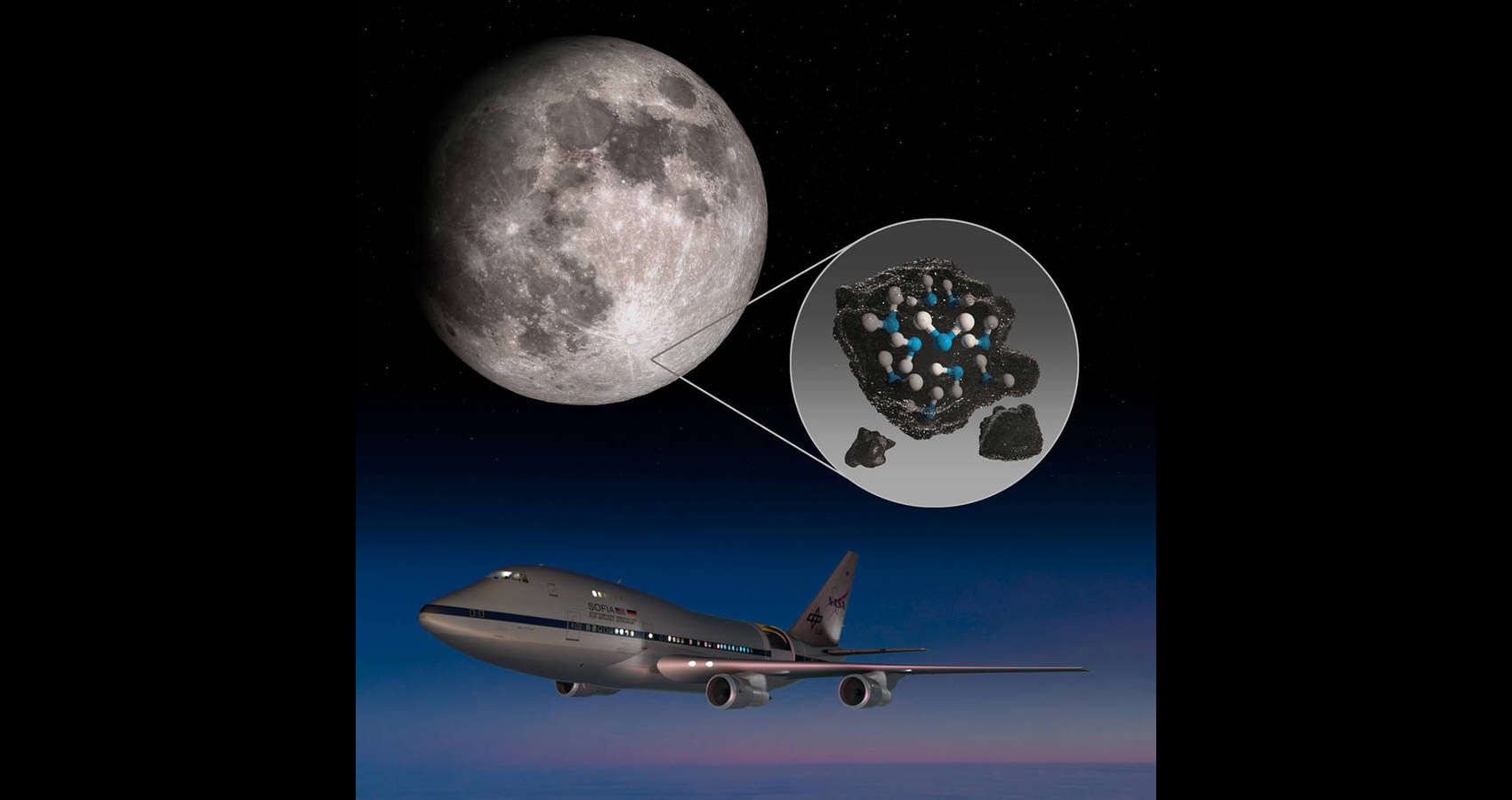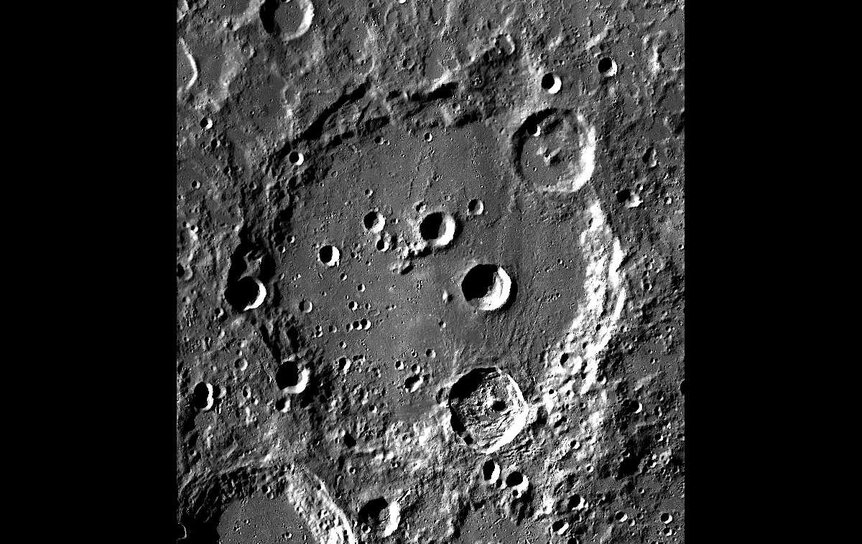Create a free profile to get unlimited access to exclusive videos, sweepstakes, and more!
Astronomers find water on the Moon glowing in sunlight

We've known for a while that water ice exists on the Moon in deep, permanently shadowed craters near the lunar poles.
New observations, though, show the presence of water in a pretty surprising place: Sunlit craters.
That's surprising because without an atmosphere to block it, high-energy ultraviolet light from the Sun tends to break apart water molecules. However, it looks like this water exists because it's being protected somehow, possibly by being locked up in tiny glass beads formed from micrometeorite impacts.
OK, let's back up a bit. How was the water found?
The observations were made with SOFIA, the Stratospheric Observatory for Infrared Astronomy, a 2.5-meter telescope that literally looks out of a hole cut out of a specially designed 747 airplane. The plane flies at an altitude of about 12 kilometers, above most of the water in Earth's atmosphere. That's important, because the telescope observes infrared light, which is absorbed by water. Getting above the water in Earth's air allows the telescope to observe this interesting part of the electromagnetic spectrum.
The astronomers used SOFIA to look at regions of the Moon around Clavius crater* and Mare Serenitatis. Clavius is located in mid-to-high latitudes in the southern hemisphere (58° S), while the mare is at low latitudes in the north (28° N). The Moon phase was waxing gibbous at the time, so both areas were lit by the Sun at the time.
What they found is what's called an emission line from water. When atoms and molecules absorb light, they can re-emit that light at very specific wavelengths (think of them as colors). Water emits at many wavelengths, one of which is about 6.1 microns, in the far-infrared. That's a wavelength SOFIA can see, which is why they used it for the observations.
The detection looks pretty good; they looked at a handful of different spots and the water emission pops up in all of them.
A nifty thing about this observation is that some previous observations don't actually see water per se, they find things like hydroxyl molecules, OH-, which when combined with hydrogen makes water molecules. This 6.1-micron line comes from water molecules themselves and not hydroxyls, so it's a clear and unambiguous detection of water. That's pretty cool.
So how much water is this? They estimate it's about 100–400 parts per million. If you dig up a cubic meter of lunar surface in these spots (1 million cubic centimeters), there would be about 100–400 grams of water in it. So, maybe enough to fill or partially fill a water bottle.
That's a significant amount. However, it turns out it's not like you can just scoop up lunar regolith and squeeze out the water. And that's because of how they think the water got there in the first place.
One way would be from the solar wind — as I wrote recently, oxygen in the Earth's atmosphere can be stripped away by the solar wind, which then blows it to the Moon.
Another, more likely source, is from micrometeorites. These are tiny (like, microscopically tiny rocks shed from comets and asteroids that orbit the Sun and can impact the Moon. They can have water molecules in them; comets are made up of a lot of water ice, and asteroids have a significant amount as well. When they hit the Moon, they can deposit them in the surface.
When they impact, they slam into rocks on the Moon at high speed, melting a very teeny tiny bit of them. This molten material resolidifies into glass beads, trapping the water molecules in them.
That would explain why they're found in direct sunlight: They're protected by the glass in the beads (though I'll note that it's also possible they're distributed in empty regions between dust grains in the regolith).
To be clear, we're talking about individual water molecules here. This isn't ice, where the molecules can bond together into crystals. So the water is distributed molecule by molecule throughout the surface.
This is a very cool discovery! The science of it is pretty interesting, and it shows us that the surface of the Moon is a much more interesting place than we might have thought.
… but. NASA announced this result as part of a press conference, one that was advertised days in advance with no topic noted except that it was about the Moon, and SOFIA was involved. Those of us who are familiar with lunar science (and NASA's history of press conferences) were pretty sure it was about water, though not the specifics.
That's fine, but listening to the press conference on Monday (26 October 2020) I was struck by how hard NASA was trying to tie this discovery to the Artemis program, the planned crewed lunar exploration missions. A lot of this lunar exploration is predicated on finding accessible water on the Moon, because water is useful for drinking (of course), but broken down in various ways into hydrogen and oxygen it can be used for air and fuel. Water is heavy, and carrying it to the Moon is expensive in terms of fuel. Having a useable source already there is a very big deal.
However, this new finding about water — again, while scientifically very interesting in and of its own — shows that the water is almost certainly not accessible. It's probably locked up in glass beads and distributed at a molecular level, making the idea of somehow mining or extracting it a bit of a non-starter. Especially when compared to the very large deposits of ice in the polar craters.
So tying this to Artemis is a reach, and I strongly suspect a political one made (or agreed to) high up in the administration. There's a lot of pressure on NASA admin to send humans to the Moon, especially with the silly and frankly dangerous deadline of 2024 imposed by Trump and his Administration. Quite a bit of the press conference was devoted to Artemis and the precursor missions to explore the Moon, indicating to me that this was a very important topic for the NASA administration to promote.
That's aggravating. The artificial 2024 deadline is a huge mistake; it's too rushed, and there's not enough time to design, build, and test the hardware needed in such a way to minimize risk. The Space Launch System rocket, vital for this, has yet to fly, and is too expensive to be sustainable (in fact, as I have been very clear about for years: I wish it would be canceled).
I want us to explore the Moon, put people there, even establish a scientific base for exploration at the poles. There's a vast amount to learn there, including just how we can develop and build such a base, which has profound implications for future exploration of the solar system.
But I want us to do it right. Sustainably, smartly, with the right motivations and proper attitude. Playing up the tenuous connection between this important new water finding and Artemis indicates to me that we're still a long way from that just yet.
*If that sounds familiar, it's where the Moon base was located in 2001: A Space Odyssey.





























